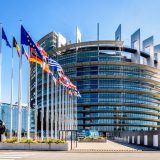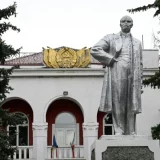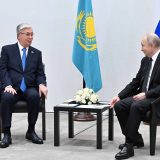One week after Marsa’s death Ahmini, the Iranian government shut down the internet, preventing any dissemination of images showing the protests and police repression. Nevertheless, the images and videos have swept in waves on the networks showing the rest of the world and in almost real-time the anti-regime protests. To circumvent this censorship, the demonstrators redouble their ingenuity and are helped by international civil organizations ; international assistance and expertise have been formed over the cuts imposed by the government.
As early as 2009, Ahmadinejad’s government had banned access to social networks, such as Twitter or Facebook, during the “Green Revolution” which challenged his re-election. In 2017-2018, the government partially restricted access to private courier services to limit the organization of protests. In 2019, the government even ordered a complete shutdown, cutting Iran off from the rest of the world for a week and during which only national digital services operated, creating a national intranet. The issue of censorship and the use of the Internet in Iran by the opposition to the regime and the demonstrators began as early as the end of the 90s and the structure of the network and its management were influenced by this danger perceived by the authorities. It is not useless to draw up the various stages of the construction of cyberspace in Iran.
The first access to the Internet in Iran developed in the academic circle with the support of the Regime and the Presidency of Khatami. The Internet was seen as an economic opportunity to revive the country devastated by the Iran-Iraq war (80-88) and was seen in conservative and religious circles as a new means of disseminating the Islamic version of the regime, but also for student circles a new means of expression beyond the control of the state censorship that controlled the media and publications [1]. Khatami’s reforming presidency (1997-2005) was marked by the wish for openness and a rapprochement between Iran and the West, which necessarily passed through education and democratization of the population on the Internet, via universities, as well as an increase in freedom of expression online. In the 2000s, personal blogs flourished and for the first time, various segments of the population could express themselves freely, get in touch, exchange ideas and criticize the regime in place. This phenomenon is often referred to as “Blogistan”[2] and is often linked to women’s and youth rights movements. Religious and conservative forces in Iran, therefore, began at this time to criticize free access to the Internet while calling for restrictions on its use.
Since Ahmadinejad’s election in 2005, supported by conservatives, bloggers and journalists have been arrested for writing on their blogs. And it was this year that rumours of a national internet project were heard. On February 7, 2006, Abdulamajid Riazi, Iran’s Minister of Information and Communication Technologies (ICTM), presented a report on the creation of a national internet, with a provisional budget of one billion US dollars, and an estimate of three years for its construction. But the project only really started in 2013 after Rouhani was elected.
The first major event was the Green movement, which was a wave of protests against Ahmadinejad’s re-election in 2009. It was the first protest movement that used social networks, mainly YouTube and Twitter, to disseminate images in time almost instantaneous and which allowed the demonstrators to organize themselves. International journalists who had been expelled from the country to avoid any coverage of the events, thus had access to the publications of “citizen journalists”, which enabled them to have new access to information and to cover the events at distance. This new use of the internet and social networks was resumed during the “Arab Spring” a few years later.
A year after the 2009 Green Movement, a second significant event influenced Iran’s internet design and management: the Flame and Stuxnet attacks. In 2010, the centrifuges used to enrich Natanz and Bouchehr ‘s uranium were victims of a cyber attack of exceptional magnitude. During Ahmadinejad’s presidency, Iran relaunched the nuclear program which had been officially suspended since the 1979 revolution. The creation of a nuclear bomb in Iran constitutes a lever of pressure from Tehran to reverse the balance of power between the United States and Israel. Possession of the bomb would make it possible to perpetuate the regime and raise itself to the rank of nuclear power. And these computer viruses have touched this strategic point in Iran to slow down the program, distorting the results and sabotaging the centrifuges which make it possible to enrich uranium[3]. This question of the enrichment rate was also at the heart of the nuclear agreement signed in 2015[4]. This cyberattack was experienced as a trauma by the regime, which subsequently tried to defend itself against all external attacks.
The question of who and how to govern the internet in Iran has long been a subject of debate and Iran has often changed positions under different presidencies. The different visions of Internet governance can be studied through the positions of States at international conferences and meetings to establish global standards in telecommunications.
In 2003, the first global meeting for Internet governance took place at the World Summit on the Information Society (WSIS) held in Geneva by the International Telecommunications Union (ITU), an agency of the United Nations. During his speech, Mohammad Khatami, Iran’s reformist president from 1997 to 2005, presented Iran’s agenda in terms of internet governance. Declaring that cyberspace was the realization of the ideal concept of a “dialogue among civilizations”. He proposed during this summit three new rights in the Declaration of Human Rights concerning cyber: the “right to its development”, the “right to communicate” and the “right to information”; with a nuance in the freedom of expression which had to be limited by the “requirements of morality and public order”[5]. Khatami also insisted on a democratic organization of global Internet governance, which would allow developing countries to play an effective role, and involve the private sector.
Ahmadinejad’s presidency was marked by a radical change of position. This change was perceptible in the positioning of the Iranian delegation during the 2nd part of the WSIS in Tunis in December 2005[6]. But the first actions of the new president fell on civil society organizations with the cancellation of the convention of the second Regional Civil Society Forum on the Information Society for the Middle East and West Asia, which was to be held in August 2005 on the island of Kish, Iran.
At the second WSIS summit, Iran had a leading role in forming a coalition of like-minded countries on internet governance. The model of governance defended and promoted by Ahmadinejad’s presidency was the creation of an intergovernmental organization dependent on the United Nations which would take over the prerogatives of ICANN: governments would have been at the centre of this organization and the private sector and organizations of civil society would only have had an advisory role. This position of Iran in favour of global governance of the Internet solely through the prism of governments was reaffirmed during the World Conference on International Telecommunications (WCIT 12 or WCIT-12) organized by the ITU in 2012. Iran and other countries in the Arab world were still marked by uprisings that had used cyberspace as a privileged medium for communicating their demands and organizing demonstrations. During this conference, a more assertive coalition of States led a campaign for Internet governance centred on States, some specialists speak of a “Westphalisation of governance”[7]. Russia led this coalition with Iran, China, Cuba, Kyrgyzstan, Sudan and Bahrain. Their views are similar to that of Iran, with governance based on government-to-government relations, putting a limitation on the ideal of an open and free internet of the pioneers of the network.
A final reversal of international posture was made by the presidency of Hassan Rouhani (2013-2021), a moderate cleric supported by Khatami. Its position on internet governance was expressed at the Global Multistakeholder Meeting for the future of Internet Governance, also known as the NETmundial Initiative in April 2014 in Sao Paulo. Rouhani ‘s new government said it was in favour of governance by a multi-partisan institution, and no longer intergovernmental as the last president had done with the support of Russia and China.
But the question of who should govern cyberspace was de facto settled in 2012 with the creation of the Supreme Council for Cyberspace. The establishment of this council was one of the responses of the Supreme Guide to settling the debate on the model of governance to adopt and the double “attack ” that Iran had suffered at the end of the 2000s: internal with the Green movement, and external with the cyberattack on nuclear infrastructure. This Council brings together the President of the Islamic Republic, the Speaker of Parliament, the Attorney General, the Director of the Islamic Republic of Iran Broadcasting (IRIB), the Minister of Information Technology and Communications, the Minister of Culture and Islamic Guidance, the commander of the Revolutionary Guards and the head of the national police ; and 7 other members appointed directly by the Supreme Guide[ 8].
Finally, this Council allows for better coordination between the differences in authorities and, from the first meeting, gave itself the prerogatives to create an Iranian internet independent of the global internet and to control the latter. This project will be put in place and will mark the 2010s, with a restructuring of the network, the development of a digital economy and a cabling policy which will be detailed in a future article.
To be continued….
[1] Babak Rahimi et Mehdi Semati, «The politics of the Internet in Iran», in Media, Culture and Society in Iran : Living with globalization and the Islamic state (Londres: Routledge, 2007), 304
[2] Khiabany, Gholam, Annabelle Sreberny, et Julien Nocetti. «Blogistan : The internet and politics in Iran». Politique étrangère Eté, no 2 (2011): 447‑72. https://doi.org/10.3917/pe.112.0447.
[3] Uranium enriched to a rate of 3% makes it possible to operate power plants to produce electricity, while 90% enrichment allows the creation of a nuclear bomb[4] The Vienna nuclear agreement with Iran, signed on July 14, 2015, between Iran, the United States, Russia, China, France, the United Kingdom, Germany and the European Union, provided for supervision of the Iranian nuclear program by the International Atomic Energy Agency (IAEA), in particular the production of enriched uranium, in exchange for a gradual lifting of sanctions. Under the agreement, Iran pledged not to produce uranium enriched to more than 3.75% for 15 years, and any uranium enriched beyond that limit had to be exported out of the country or diluted; to prevent the production of a nuclear weapon. But since the US pulled out of the deal in 2018, the parties’ relations with Iran have soured. The issue of uranium enrichment is still a lever of pressure that Tehran has. On November 22, 2022, Iran announced that it was producing 60% enriched uranium.
[5] OpenNet. «Internet Filtering in Iran in 2004-2005: A Country Study | OpenNet Initiative», 2005. https://opennet.net/studies/iran2005#68
[6] Safshekan Roozbeh, «Iran and the global politics of internet governance», Journal of Cyber Policy 2, no 2 (18 août 2017), https://doi.org/10.1080/23738871.2017.1360375
[7] Nocetti, Julien. «Contest and Conquest: Russia and Global Internet Governance». International Affairs 91, no 1 (janvier 2015): 111‑30. https://doi.org/10.1111/1468-2346.12189
[8] Ali Khamenei, «حکم تشکیل و انتصاب اعضای شورای عالی فضای مجازی (Decree on the Formation and Appointment of Members of the Supreme Cyberspace Council)» (2012), https://farsi.khamenei.ir/print-content?id=19225.
[Image] Sign at a historic site indicating that this place is filmed by a CCTV camera; Shiraz, Iran; August 2018







